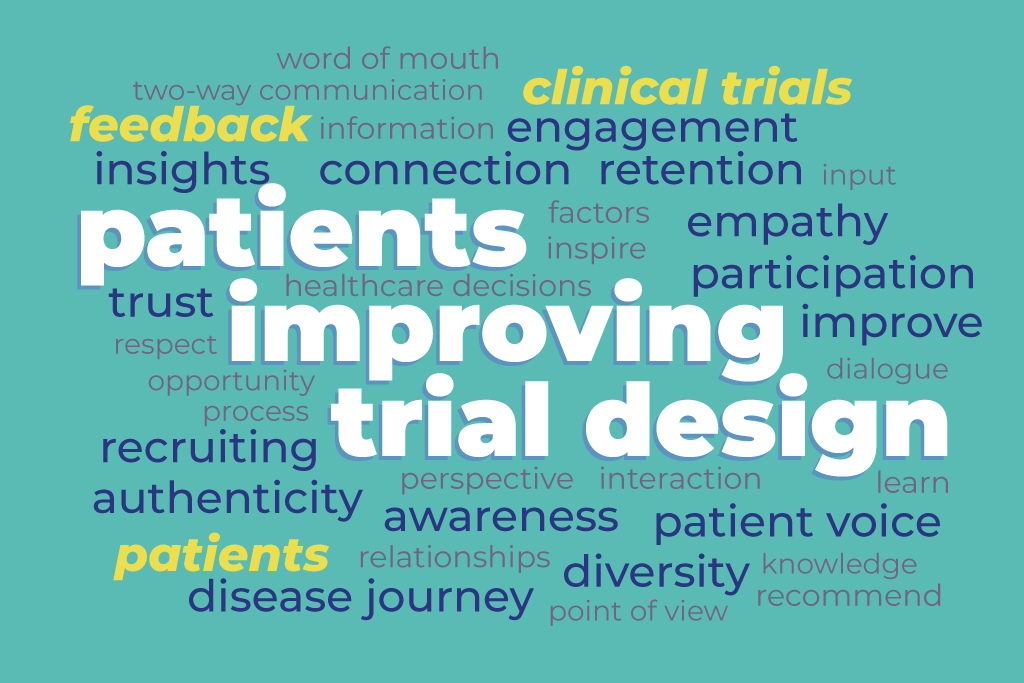By: Clinical Partnerships Team
Part 2 of 3: How patients can improve clinical trial design
This blog is part 2 of a series on the impact and benefits of patient involvement with the clinical trial process – patient willingness to participate in trials, what they can contribute beyond their role as a study participant and how to most effectively find and communicate, and engage with them. Read Blog #1: https://reverba.com/building-connections-for-clinical-trials-how-patients-can-improve-trial-enrollment-engagement/
In this second blog in the series, we’ll look at how patient input and interaction can help improve clinical trial design, reduce costs, and improve overall retention and clinical trial experience.
There are so many challenges around designing clinical trials that it can often be difficult to decide where to focus your efforts and resources to improve the process. Based on our recent surveys of clinical trial participants, we see that early engagement with patients can change the course of a study for the better – and research shows it can directly impact the cost of conducting the trial as well.
We conducted a survey of more than 400 people, asking about their knowledge of and experience with clinical trials and their feelings about participating in them and contributing to the clinical trial process.
The results show that patients clearly stated that they want to participate in the development process. Among those who had been in a clinical trial previously and reported having a positive experience, 89% were open to helping trial organizers design the trial more effectively – and 60% who reported a negative experience were willing to help as well. And when asked for what they consider to be the most important thing organizers can do to demonstrate they value patients as true partners in a clinical trial, 30% said “provide open communication.” So patients are ready to interact, and they can give input across a range of topics.
Our survey also showed that simple logistics are top of mind for patients when choosing whether to participate in a clinical trial, with 32 percent of respondents citing location or transportation conflict as a reason for not participating. Knowing about these concerns early enables trial planners to adjust specific clinical trial operational factors that have been identified to impact enrollment or retention.
For example, investigators might be planning to require patients to have blood draws two or three times a week to measure biomarkers that are of interest but not required for product approval. Feedback from patients might lead to the decision to reduce or remove those tests, making the trial more “patient friendly” and adjusting the trial to better match real-world patient time restrictions. And, if scheduling or location might be perceived as an obstacle for patients, developing a flexible schedule, clustering required appointments, or something as simple as arranging for a car service to assist with transportation might make all the difference in keeping a patient enrolled. Patient feedback during the trial development process can also highlight a range of diversity issues that may need to be addressed, ranging from materials language and presentation to trial sites and staffing.
A publication by the National Health Council cites a number of examples of clinical trial improvements based on patient input and feedback, including: (1)
- CoLAB (Eli Lilly & Co.) is a clinical-trial project designed to integrate clinical researchers, patients, health providers, and study coordinators in drug development through in-person simulations of clinical trials. During simulations, a “dress rehearsal” of a clinical trial occurs, which helps quell the uncertainty and anxiety that can come from the clinical-trial experience. Each simulation gives researchers the chance to reduce study burden on patients. Adjustments to protocols that have results include changes to medication delivery to blister packs from bottles to help people unable to open child-proof packages and reducing the number of invasive procedures needed or eliminating them entirely.
- Janssen researchers asked patients in a clinical trial for age-related macular degeneration to participate in mock trial initiation at a clinical trial site. Researchers learned that shortening visits and providing transportation to the site would improve people’s experiences participating in the trial. The following year, no patient withdrew from the actual trial, which is a significant improvement over the average drop-out rate of 18%.
And patient feedback specific to a trial under development before it is finalized can help avoid potentially costly mistakes, because each change that must be made after a trial is underway can carry a steep price. Kenneth Getz, director of sponsored research programs at Tufts University and emeritus member of the Executive Committee of the Clinical Trials Transformation Initiative, is a pioneer in measuring this impact. His often-cited research, published in the journal Therapeutic Innovation & Regulatory Science, shows that the cost for each change made during a clinical trial can range from $100,000 to $500,000+ per change.(2)
- National Health Council, Patient-Focused Medical Product Development Case Examples, https://nationalhealthcouncil.org/additional-resources/patient-focused-medical-product-case-examples/
- Getz KA, Stergiopoulos S, Short M, et al. The Impact of Protocol Amendments on Clinical Trial Performance and Cost. Therapeutic Innovation & Regulatory Science. 2016;50(4):436-441. doi:10.1177/2168479016632271 https://doi.org/10.1177/2168479016632271
